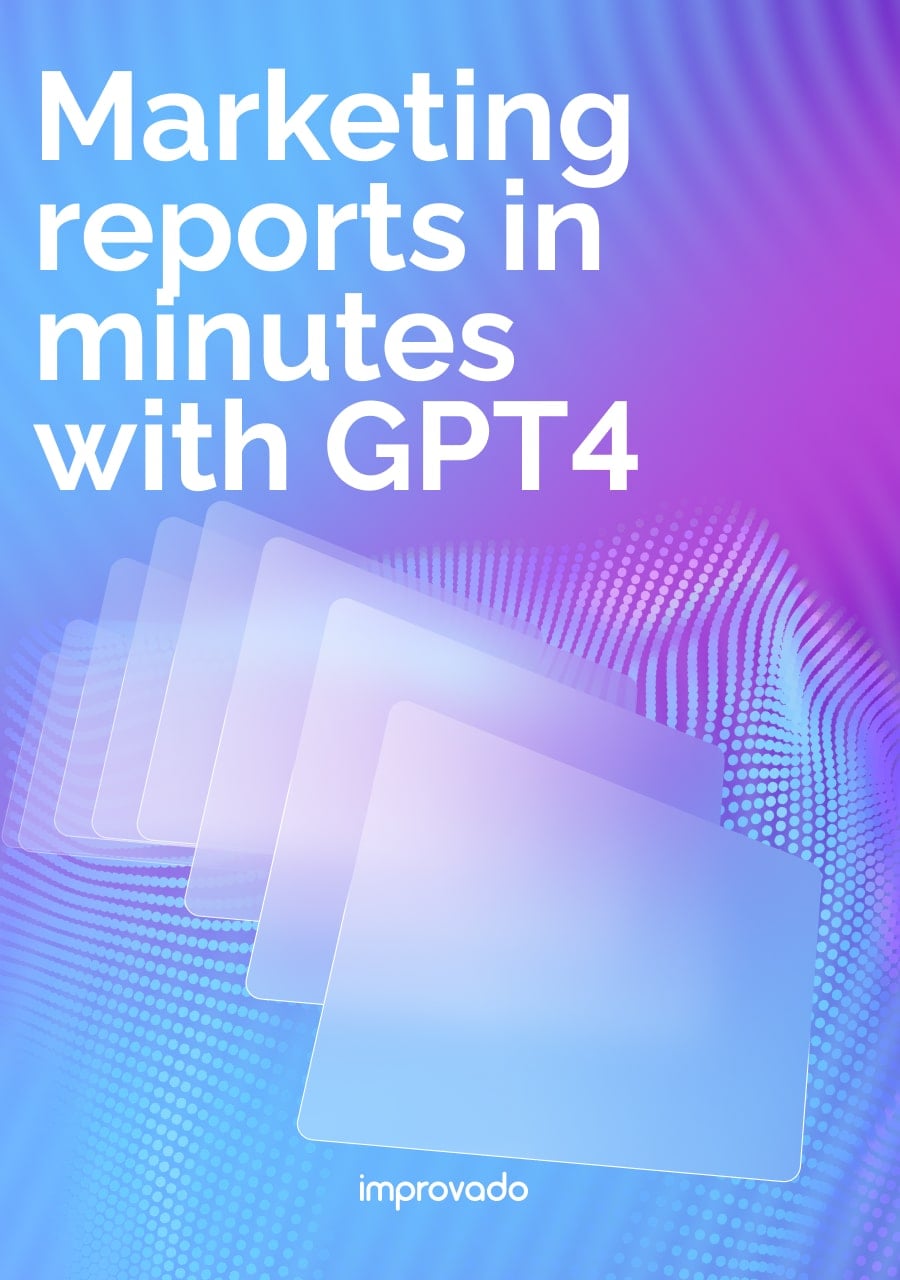In 2023, artificial intelligence has made a huge leap, and marketing is gaining the most out of it. AI is enhancing how brands understand and meet customer needs, moving beyond traditional methods. This shift towards AI-driven methods is reshaping the way companies approach marketing campaigns, bringing in new avenues for creative, personalized, and impactful advertising campaigns that resonate deeply with audiences. This guide explores the key aspects of leveraging AI for marketing campaigns ideation and execution.
What Is an AI Marketing Campaign?
Unlike traditional campaigns that follow static rules, AI-powered campaigns continuously learn from customer behavior, adjusting creative, channel mix, and audience segmentation based on performance feedback loops.
Here's a good illustration of different AI applications in marketing campaigns:
- The blue circles represent the use of machine learning,
- The green ones represent the use of propensity or predictive models,
- And the pink ones represent AI applications.
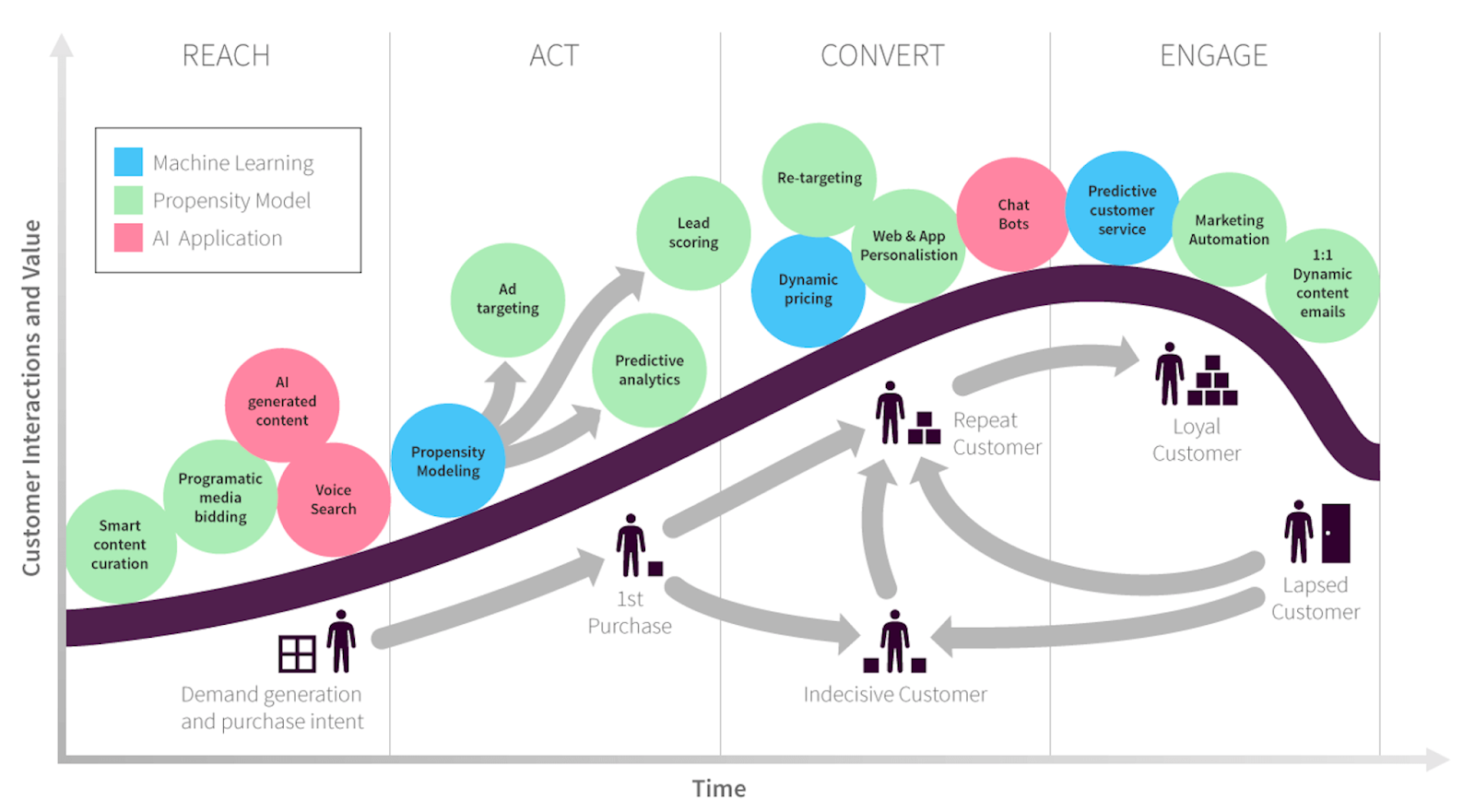
Examples of AI Marketing Campaigns
Before diving into specific AI technologies and strategies, it’s helpful to see how real-world campaigns have already put them into action.
1. Nike: Never Done Evolving
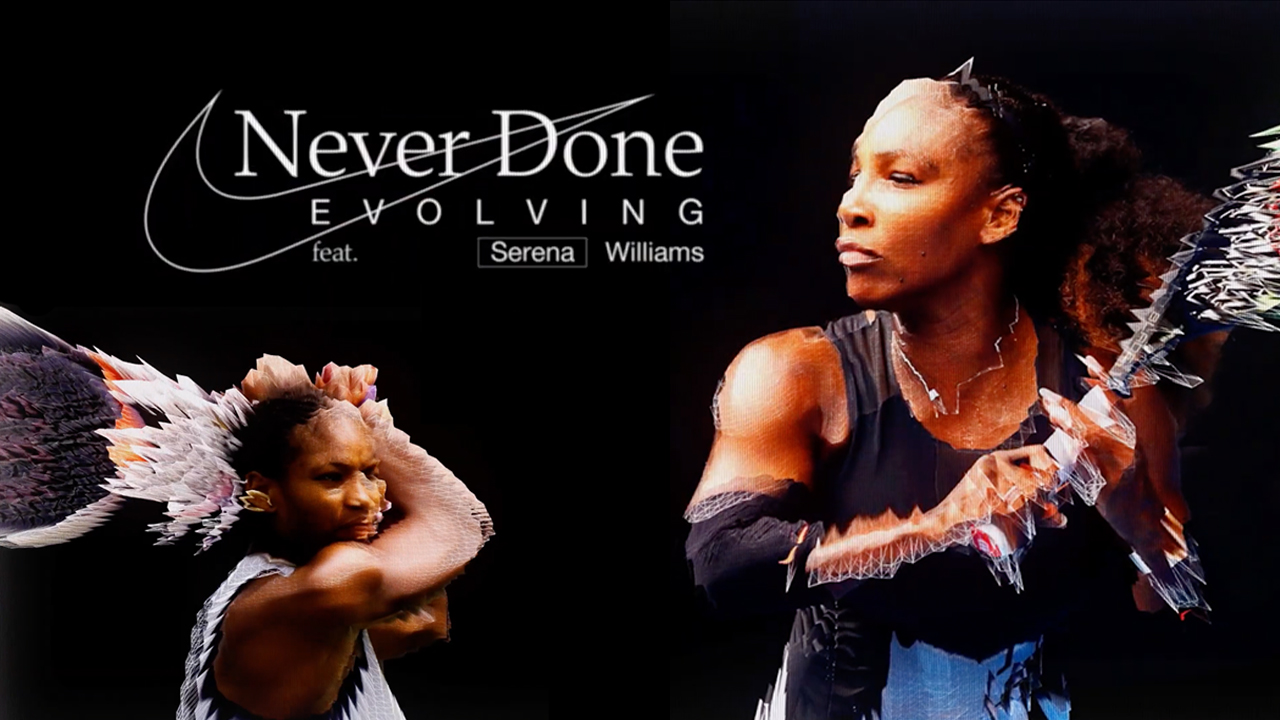
AI technologies: Computer vision, generative AI, real-time data synthesis.
Channels: YouTube, social media, experiential microsite, earned media.
Results:
- The campaign generated over 4.2 million views in the first 48 hours, demonstrating an increase of 1082% in organic views compared to other Nike content and breaking the company views record.
- It earned significant media coverage.
- The campaign won multiple Cannes Lions awards for its innovation and creative use of AI in sports marketing.
Nike’s “Never Done Evolving” campaign featured a virtual tennis match between Serena Williams in her rookie year and her 2022 self. The company used machine learning models trained on decades of match footage to analyze Serena’s playing style, footwork, and shot patterns at different stages of her career.
Generative AI and real-time rendering tools simulated a lifelike match between the two versions, broadcast across digital and social channels. Viewers could explore in-depth player data and AI-driven predictions on a custom microsite, creating an immersive storytelling experience around athletic progression and excellence.
2. Heinz: AI Ketchup Campaigns
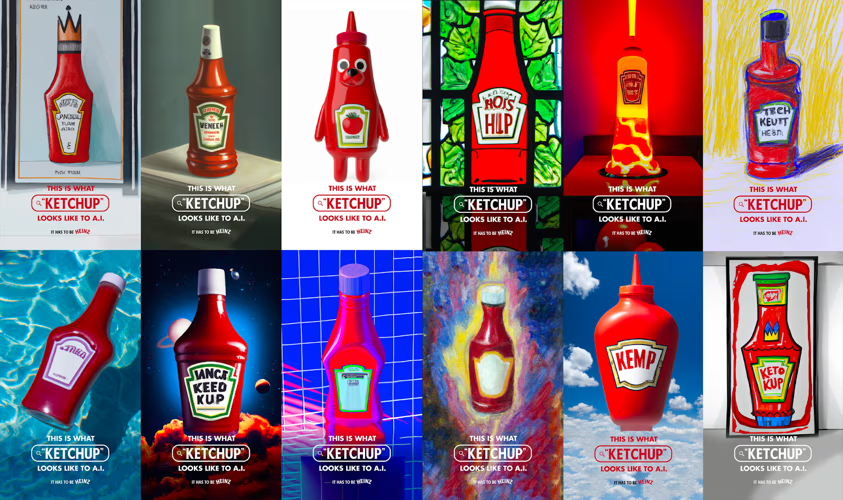
AI technologies: Generative AI (DALL·E 2), computer vision, image recognition.
Channels: Social media, PR, digital display, branded microsite.
Results:
- The campaign earned over 1 billion impressions, worth over 2500% more than the brand media investment
- It also secured press coverage in mainstream and marketing media.
- The brand social engagement rate was 38% higher than benchmarks.
Heinz launched a creative experiment by prompting DALL·E 2 to generate images using the phrase “ketchup” and variations like “ketchup in outer space” or “renaissance painting of ketchup.” The AI consistently generated visuals resembling Heinz bottles.
The brand extended the campaign by inviting consumers to submit their own AI-generated ketchup artwork, showcasing submissions on a digital gallery and in select out-of-home placements.
3. Virgin Voyages: Jen AI Campaign

AI technologies: Generative video, voice synthesis, augmented reality.
Channels: Social media, experiential microsite, email invites.
Results:
- The campaign generated over 2 billion impressions.
- Users generated more than 25,000 personalized videos, significantly boosting engagement and capturing high-intent leads through interactive content.
Virgin Voyages partnered with Jennifer Lopez to launch “Jen AI,” a campaign built around hyper-personalized video invites. Users could generate customized messages, delivered by an AI Jen, inviting friends and family to book a Virgin Voyages cruise.
The campaign leveraged deep learning tools to mimic her voice and appearance, creating realistic and engaging outputs in seconds.
The experience was delivered through a microsite and amplified across social channels and email, driving viral attention and shareability.
4. British Council: Localized AI Ads Campaign
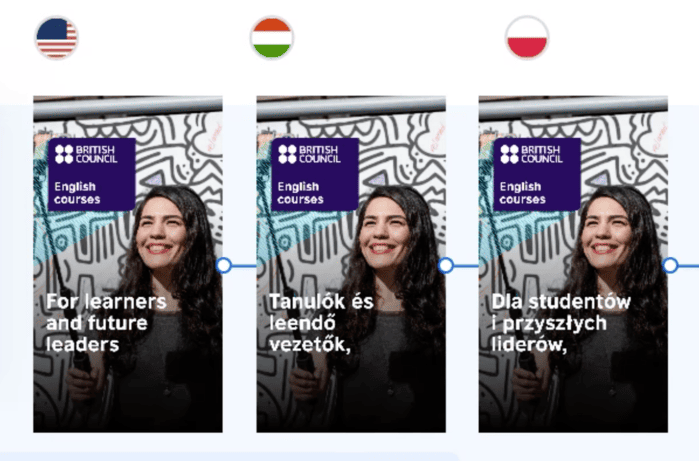
AI technologies: Template-based design automation, dynamic asset generation.
Channels: Programmatic digital ads, social media, multilingual microsites.
Results:
- The British Council achieved a 70% reduction in marketing content creation costs with a 50% reduction in turnaround time.
- The company has a 100% on-time delivery of all localised materials.
The British Council needed to scale its “Global English” campaign across multiple countries and languages without ballooning costs or production timelines. By using AI-driven design tools, it automated the creation and localization of over 1,000 ad variations in seven languages, all while maintaining brand consistency and regional relevance.
Templates dynamically incorporated localized messaging and visual elements, reducing manual design work. This process enabled global teams to publish campaign assets faster and with fewer resources.
5. Function Growth: Campaigns Backed by AI Insights
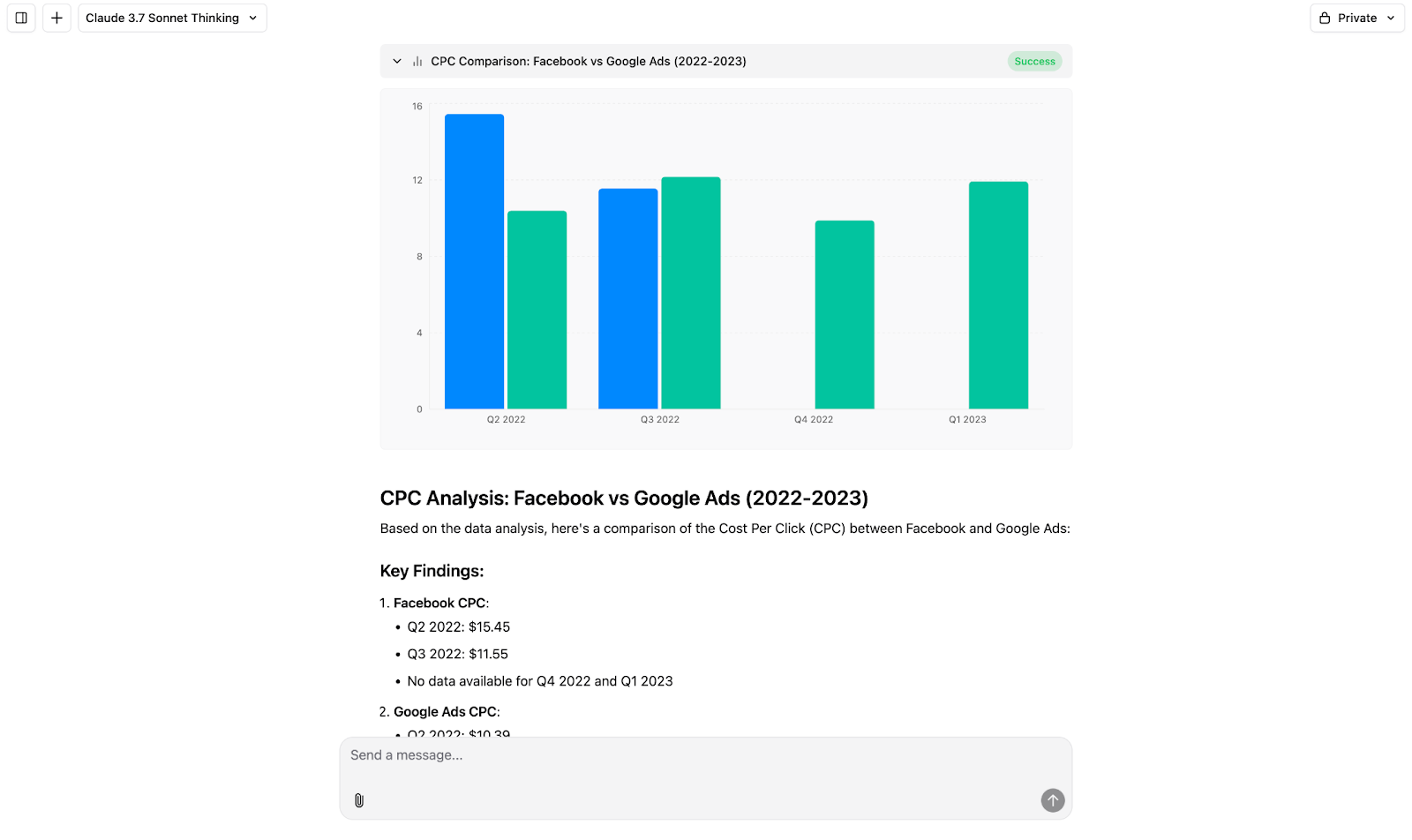
AI technologies: AI Agent, natural language processing technology, large language modelling.
Channels: Advertising and ecommerce platforms.
Results:
- The agency achieved a 30% boost in marketing team productivity.
- The team cut six hours of reporting time per week.
As said in the first section, AI isn’t just being used to create ad content; it is used throughout the whole campaign lifecycle, including performance optimization.
Function Growth, a performance marketing agency focused on D2C brands, implemented an AI Agent to streamline campaign analysis and optimization. Rather than relying on manual reporting and reactive decisions, the AI Agent continuously monitored campaign data, detected trends, and surfaced actionable insights directly within the team's workflows.
The system proactively flagged performance shifts and suggested budget reallocation, allowing marketers to adjust campaigns in real time. By eliminating the lag between data collection and decision-making, Function Growth shifted its team’s focus from reporting to optimization.
Read the Function Growth case study to learn more details.
8 Ways AI Is Transforming Marketing Campaigns
AI isn't just one tool, but a collection of advanced technologies, each bringing unique strengths to the table.
Let's explore the diverse range of AI techniques that are currently driving AI ad campaigns.
1. Machine Learning (ML): The Precision Tool
The core functionality of ML in AI marketing campaigns
- Pattern recognition: ML excels at sifting through vast data to spot trends and anomalies. This capability is crucial for understanding customer behaviors and preferences, and predicting future actions.
- Target audience segmentation: By analyzing customer attributes and behaviors, ML can segment audiences into highly specific groups. This goes beyond basic demographics, machine learning models analyze interactions, purchase history, and content preferences to create finely defined audience segments, ensuring that each campaign targets the customers most likely to convert. One example of ML-powered targeting is Google Ads Smart Bidding, which automatically adjusts bids in real-time based on the likelihood of conversion, factoring in signals such as device, location, time of day, and user behavior.
- Optimized budget allocation: ML algorithms can examine past campaign performance across channels and automatically recommend where to allocate budget for the best returns.
- Dynamic content personalization: Machine learning enables personalization at scale. It can dynamically adjust campaign content (emails, ads, website offers) based on individual user behavior and preferences. For instance, an e-commerce marketer can use ML to show different product recommendations or ad visuals to different users in real time.
- Performance forecasting: ML algorithms can project the future performance of marketing campaigns, helping marketers anticipate outcomes and make proactive adjustments.
2. Natural Language Processing (NLP): Bridging the Communication Gap
NLP use cases in AI campaigns:
- Understanding customer sentiment: NLP excels in sentiment analysis, parsing customer feedback, social media conversations, and online reviews to gauge public sentiment toward brands, products, or campaigns. By detecting positive, negative, or neutral sentiments, marketers can quickly identify PR crises, address customer pain points, or reinforce messages that are winning praise.
- Voice analysis: Beyond social media, NLP can analyze direct voice-of-customer data such as survey responses, support tickets, and call transcripts. By categorizing and interpreting this feedback, NLP tools can surface common themes that marketers can use to refine their campaigns or product positioning.
- Content optimization: NLP isn’t just about understanding text, it can also generate and optimize it. NLP tools can suggest improvements to ad copy or landing page text to better align with target audience interests and search engine keywords. Some advanced systems analyze top-performing content in an industry to recommend topics or even automatically draft first versions of marketing copy.
- Voice search optimization: As voice search becomes more prevalent, NLP is pivotal in optimizing content for this medium. It ensures that verbal queries align with the content, improving a brand’s visibility in voice search results.
3. Large Language Models (LLM): Chatting with Your Data
In AI marketing campaigns, this capability is opening up a new frontier: AI agents and conversational analytics that let marketers interact with their data in natural language and optimize campaigns in real-time.
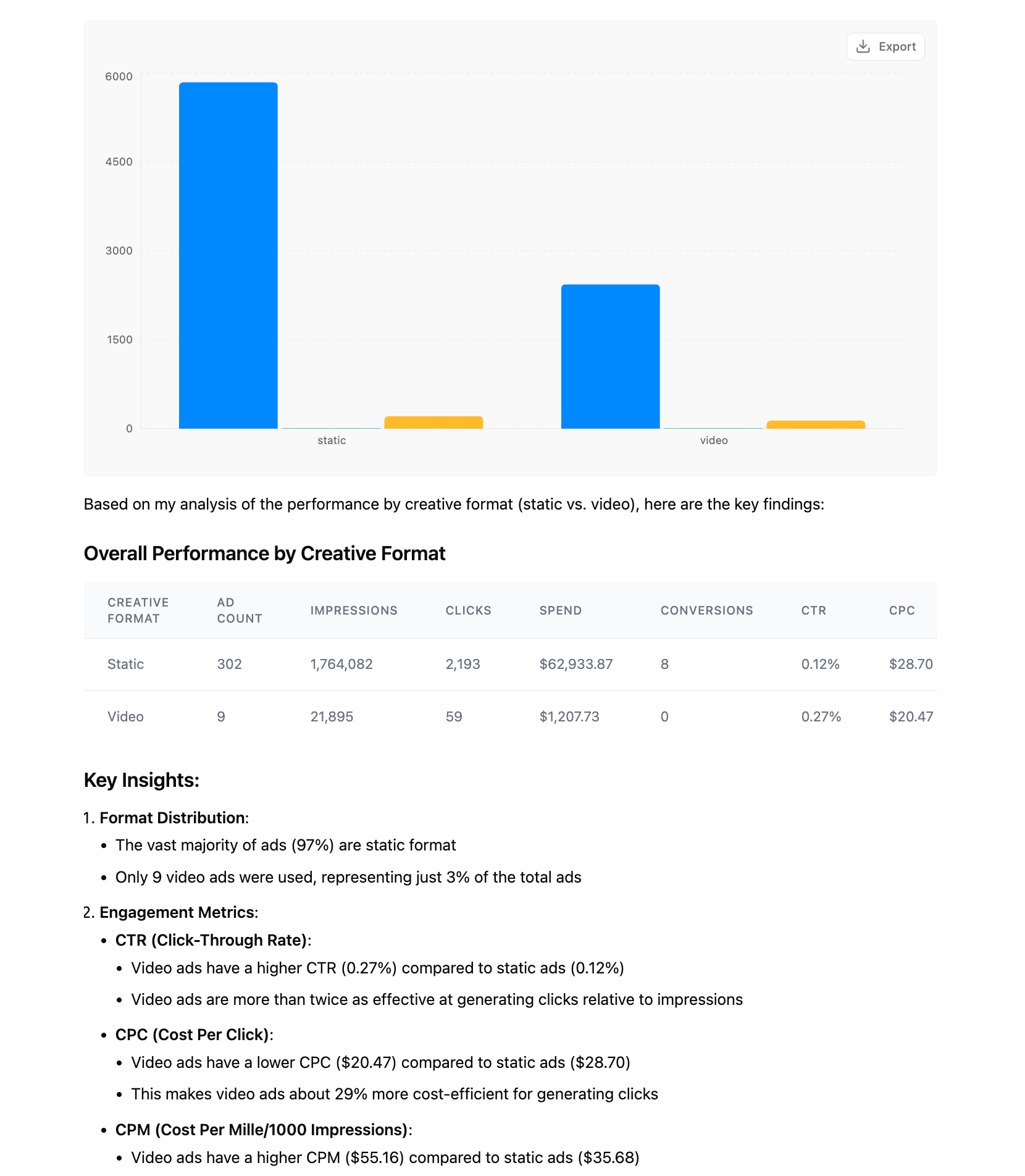
Improvado AI Agent is an example of an LLM-driven marketing analyst solution that can translate natural language prompts into real-time analysis, visualizations, strategic documents, and automated actions.
It connects directly to your unified data pipeline, enabling dynamic queries, anomaly detection, campaign comparisons, and cross-platform insights, all without manual SQL.
Users can customize context by defining business-specific terminology and data models, creating a truly embedded intelligence layer within their existing workflow.
Key use cases:
- Real-time performance monitoring: Identify campaigns with high spend and low ROI or surface top-performing ads by impressions or conversions without waiting for manual reports.
- Cost efficiency analysis: Track CPL, CPC, and other unit economics across campaigns to optimize media spend and reduce acquisition costs.
- Creative performance evaluation: Compare CTRs and conversion rates across creative formats, headlines, and message themes to identify what resonates with target audiences.
- Channel and format benchmarking: AI Agent searches the web to pull benchmark data relevant to your industry, ad networks, or campaign types and compares it to your data.
- Conversion funnel diagnostics: Use AI prompts to surface conversion drop-offs and receive suggestions to improve lower funnel performance metrics.
- Media mix optimization: Compare performance and efficiency across campaign types and platforms to guide budget shifts and reallocation decisions.
4. Image Recognition: The Visual Scanner
Image recognition use cases:
- Analyze the influence of color on consumer behavior: AI image vision can analyze the visual elements of an advertising campaign, such as color schemes, imagery, and branding elements like logos or product placement. This analysis can reveal how these elements contribute to the campaign's overall performance. For instance, it might find that certain colors or images resonate more effectively with the target audience, leading to higher engagement rates.
- Monitor brand visibility across various platforms: This helps marketers understand the reach and impact of their visual branding efforts and can inform decisions about future ad placements and brand partnerships.
- Leverage AI for contextual Ad placement: By analyzing the content and context of potential ad spaces, AI ensures that ads are placed in the most relevant and engaging environments. This targeted approach helps in maximizing ad effectiveness and audience relevance, potentially leading to better conversion rates and ROI.
- Real-time ad performance optimization: AI image vision can provide immediate feedback on how certain visual elements are performing, allowing marketers to make data-driven adjustments. This could involve tweaking visual elements, changing ad placements, or altering the campaign's visual messaging to better align with audience preferences.
5. AI Image Generation: From Text to Visual in Minutes
The core use cases of the image generation technology in AI ad campaign:
- Rapid visual prototyping: Marketers can go from concept to visual in a matter of minutes by inputting a textual prompt and letting the AI create multiple image options. This empowers teams to quickly create visual content directly from campaign ideas or copy without waiting days for a design team.
- Cost-effective scalability: The case of the British Council shows that AI image generation reduces the need for large design budgets or lengthy photoshoots. Small marketing teams can produce high-quality creative assets that previously might have required outsourcing to agencies or hiring illustrators. AI-generated visuals ease time and budget constraints by cutting down reliance on manual graphic design, while still allowing customization and iteration.
- A/B testing creative at scale: AI image generation makes it feasible to test many more creative variations than before. Marketers can swiftly generate dozens of image variants for an ad, tweaking the background, the product angle, or colors, and run experiments to see which version resonates most with the audience. This rapid iteration for visual A/B testing enables campaigns to be optimized for engagement based on data rather than gut feelings.
The Nutella case shows how AI image generators help launch campaigns at an outstanding scale. The company leveraged AI image generation technology to come up with 7 million unique Nutella jar designs. The label design algorithm completed the task that would otherwise require an army of designers.
Mira los brillantes diseños de botes que “Nutella Unica” creó en Italia. #Packaging #DiseñoEmpaque pic.twitter.com/CqDQuVjTiT
— Soy Marketing (@soy_marketing) June 16, 2017
6. Deep Learning: Unearthing Deeper Insights
How to use deep learning in AI marketing campaigns
- Analyzing customer behavior: Use deep learning technology to analyze data from multiple sources, including social media interactions, website traffic, and purchase history. By processing this information, it identifies patterns and trends that might be invisible to conventional analysis methods. Marketers can leverage these insights to tailor their campaigns more effectively, ensuring that they resonate with their target audience.
- Predictive modeling: By analyzing past campaign data, deep learning tools can predict future consumer responses and buying patterns. This foresight allows marketers to adjust their strategies proactively, focusing on areas with the highest potential return on investment.
- Optimizing ad campaigns: Deep Learning algorithms can optimize bidding strategies and ad placements in real-time. By constantly analyzing campaign performance data, they adjust bids and placements to maximize visibility and conversion rates. This real-time optimization ensures that ad budgets are utilized effectively, yielding better results.
- Enhancing creative content: Deep learning aids in creating more impactful creative content. By analyzing successful elements in past campaigns, it can guide the creative process, suggesting themes, colors, and imagery that are more likely to engage the target audience.
7. Predictive Analytics: Forecasting the Future
How to apply predictive analytics for ad campaign success
Predictive analytics in AI marketing campaigns offers a data-driven approach to planning and executing marketing strategies:
- Campaign result prediction: Predictive analytics allows marketers to estimate the potential success of a campaign before it even launches. By analyzing past campaign data, AI can predict customer responses, conversion rates, and potential revenue, enabling marketers to make informed decisions and allocate resources more effectively.
- Customer behavior forecasting: Predictive analytics can analyze past buying patterns and engagement data to forecast future customer actions, such as likelihood of purchase, product preferences, and potential churn. This insight is invaluable for targeting and personalizing marketing efforts.
- Budget optimization: By predicting which channels and tactics are likely to yield the best results, marketers can optimize their spend, reducing waste and increasing ROI.
- Lead scoring and prioritization: Not all leads are created equal. Predictive analytics can score leads based on their likelihood to convert, helping marketing teams prioritize their efforts and tailor their approach to each segment.
- Ad content and placement optimization: By analyzing which types of ad content and placements have historically performed best, predictive analytics can guide marketers on how to craft and place future ads for maximum impact.
Volkswagen has been using artificial intelligence in its media buying strategies in Germany for a while, with significant success.
The use of AI recommendations has led to higher car sales compared to those achieved through traditional media agency recommendations. The brand saw a 14% increase in dealership orders for a particular model using AI recommendations.
8. Semantic Analysis: Understanding Context
How to apply AI-powered sentiment analysis to campaign analysis
- Content relevance and optimization: For content to resonate with the target audience, it needs to align with their interests and search intents. Semantic analysis aids in crafting content that aligns with these aspects, enhancing relevance and engagement.
- Ad targeting precision: In advertising, the context in which a message is placed can significantly impact its reception. Semantic analysis helps in placing ads in the most contextually relevant environments, ensuring they reach the audience when they are most receptive to the message. This increases ad effectiveness and drives better campaign results.
- Automated content curation: By understanding the semantics of different content pieces, AI can automate the process of content curation for marketing purposes. This ensures that only the most relevant and contextually appropriate content is selected for campaigns, saving time and enhancing campaign quality.
- Brand monitoring and reputation management: Semantic analysis is crucial for monitoring how a brand is perceived across digital platforms. It helps identify not just where the brand is mentioned but also the context of these mentions, allowing for a more proactive approach to reputation management and brand image cultivation.
Best Practices for AI-Powered Campaigns
What makes AI so impactful in marketing is its dual ability to scale and personalize simultaneously.
Tasks that once overwhelmed human teams, like analyzing millions of data points, customizing content for each user, and monitoring media 24/7, can now be handled by AI at scale.
But running AI-powered marketing campaigns requires more than just plugging in a new tool.
Below are best practices to ensure your AI implementation delivers measurable impact without sacrificing control or visibility.
- Prepare your data first: AI models are only as effective as the data they’re trained on. Ensure all marketing and sales data is consolidated into a clean, structured format, ideally via an ETL pipeline or platform like Improvado. Normalize naming conventions, metric definitions, and date ranges across channels to avoid fragmented insights.
- Use AI for tactical optimization, not just automation: Move beyond basic automation. Use AI for budget pacing, creative rotation based on engagement patterns, anomaly detection, or media mix modeling. These tactical use cases drive tangible uplift when integrated into daily campaign management workflows.
- Maintain human oversight: AI can surface recommendations, but human context is required to assess nuance, such as campaign goals, brand positioning, or seasonal strategy. Establish clear workflows where marketing analysts review and validate AI-suggested changes before activation.
- A/B test AI vs. rule-based campaign tactics: To justify adoption, compare AI-optimized performance against traditional tools. Use controlled experiments to validate effectiveness before scaling across accounts.
- Document prompts and outputs for reproducibility: For generative AI and LLM-driven tools, maintain a documented library of prompts, expected outputs, and results. This improves knowledge sharing across the team and helps refine prompt engineering based on observed outcomes.
The Future of AI in Marketing Campaigns
AI is no longer a niche experiment in marketing—it’s becoming a core operating layer for data-driven teams. In the next 2–3 years, expect broader adoption of real-time optimization, cross-channel orchestration, and AI Agents.
AI won’t just inform decisions, it will actively participate in shaping and managing campaigns at scale.
Make this shift with Improvado AI Agent.
The agent helps teams move beyond static dashboards and manual reports. The Agent transforms raw data into contextual insights and campaign actions through natural language queries. It accelerates analysis, surfaces real-time opportunities, and supports strategic decisions, all within a governed environment.
Request a demo and see AI Agent in action.
.png)
.jpeg)



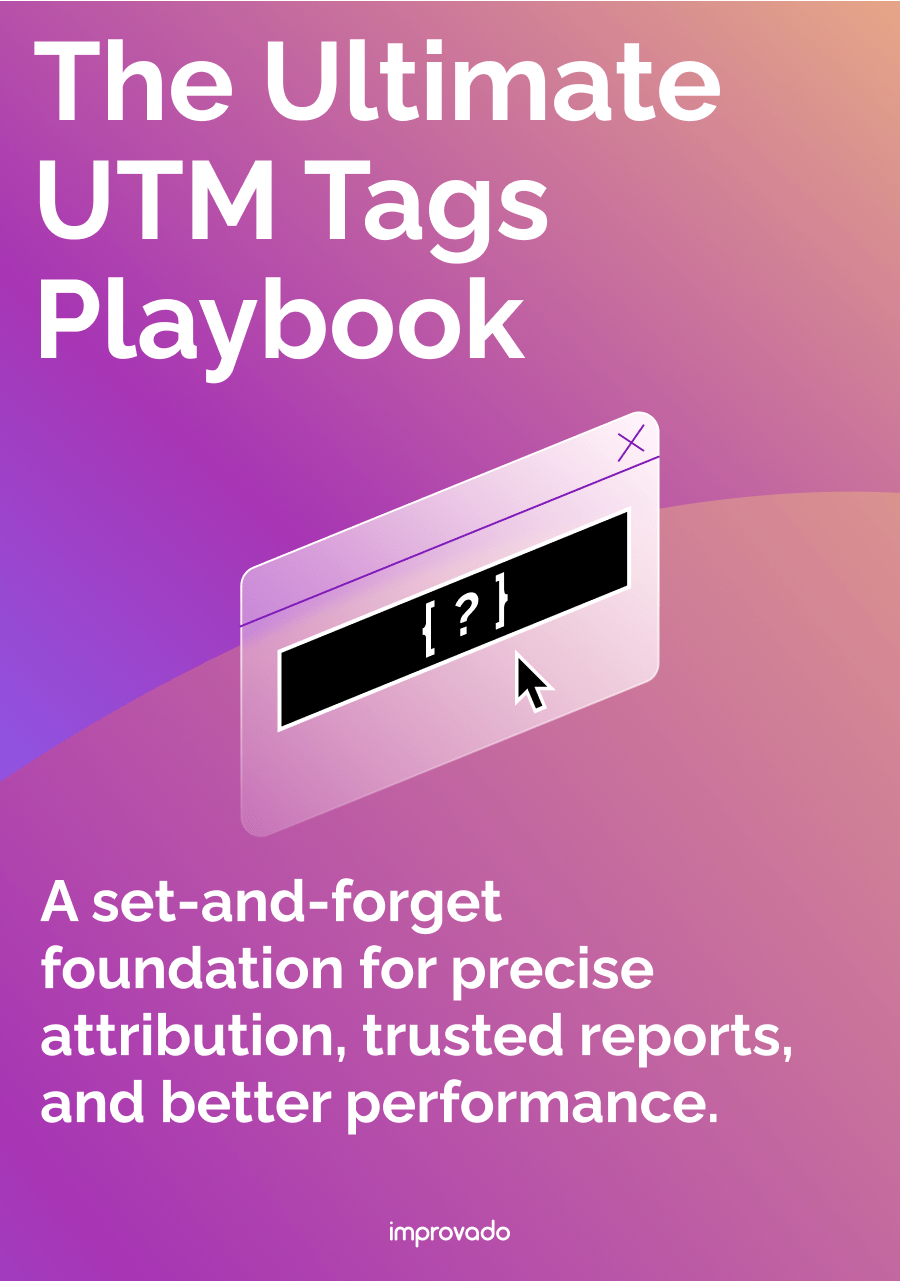
.png)
